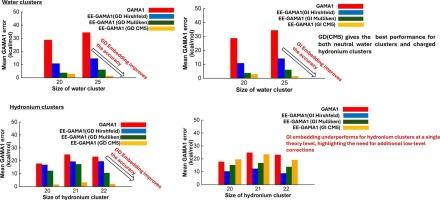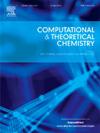Electrostatically embedded grid-adapted many-body analysis (EE-GAMA): A charge embedded fragment-based quantum chemistry method for accurate modelling of neutral and charged molecular clusters
IF 3
3区 化学
Q3 CHEMISTRY, PHYSICAL
引用次数: 0
Abstract
Accurate quantum mechanical modelling of large molecular systems remains a formidable challenge due to the steep computational scaling of conventional methods. Fragment-based quantum chemistry approaches offer a more efficient alternative, but their accuracy is often limited by the neglect of long-range inter-fragment electrostatic interactions. To overcome this, we introduce Electrostatically Embedded Grid-Adapted Many-Body Analysis (EE-GAMA), a fragment-based quantum chemistry method that combines systematic many-body energy decomposition with electrostatic embedding based on overlapping spatial grid-based fragments. In EE-GAMA, electrostatic charge embedding is implemented within the Many- Overlapping Body (MOB) expansion framework, an approach rarely explored in previous studies. Each fragment is embedded in the electrostatic field generated by background point charges derived from Mulliken, Hirshfeld, or CM5 charge models, and both Geometry Dependent (GD) and Geometry Independent (GI) embedding schemes are investigated. Our primary goal is to accurately reproduce full-system energies at the MP2/6-311G(d,p) level. Benchmark calculations on neutral water clusters and hydronium clusters show that EE-GAMA achieves near full-system MP2 accuracy and significantly outperforms the non-embedded GAMA method. In charged systems, EE-GAMA effectively captures long-range electrostatics and consistently demonstrates that GD embedding offers greater accuracy than GI, underscoring the importance of environment-specific charge representation in highly polarized systems. While GI embedding offers computational simplicity, GD embedding provides enhanced reliability in such contexts. Overall, EE-GAMA offers an excellent balance between computational efficiency and accuracy and lays a strong foundation for the future development of advanced embedding schemes incorporating polarization and charge-transfer effects in large-scale quantum calculations.

静电嵌入网格适应多体分析(EE-GAMA):一种基于电荷嵌入片段的量子化学方法,用于中性和带电分子簇的精确建模
由于传统方法的计算缩放,大分子系统的精确量子力学建模仍然是一个艰巨的挑战。基于碎片的量子化学方法提供了一种更有效的替代方法,但其准确性往往受到忽视远程碎片间静电相互作用的限制。为了克服这一问题,我们引入了一种基于碎片的量子化学方法,将系统的多体能量分解与基于重叠空间网格碎片的静电嵌入相结合,即静电嵌入多体分析(EE-GAMA)。在EE-GAMA中,静电电荷嵌入是在多重叠体(MOB)扩展框架内实现的,这是以往研究中很少探索的方法。每个片段嵌入到由Mulliken, Hirshfeld或CM5电荷模型导出的背景点电荷产生的静电场中,并研究了几何相关(GD)和几何无关(GI)嵌入方案。我们的主要目标是精确再现MP2/6-311G(d,p)级的全系统能量。中性水团簇和水合氢离子团簇的基准计算表明,EE-GAMA达到了接近全系统MP2精度,显著优于非嵌入式GAMA方法。在带电系统中,EE-GAMA有效捕获远程静电,并一致证明GD嵌入比GI提供更高的准确性,强调了在高极化系统中环境特异性电荷表示的重要性。虽然GI嵌入提供了计算的简单性,但GD嵌入在这种上下文中提供了增强的可靠性。总体而言,EE-GAMA在计算效率和精度之间提供了良好的平衡,为大规模量子计算中结合极化和电荷转移效应的先进嵌入方案的未来发展奠定了坚实的基础。
本文章由计算机程序翻译,如有差异,请以英文原文为准。
求助全文
约1分钟内获得全文
求助全文
来源期刊

Computational and Theoretical Chemistry
CHEMISTRY, PHYSICAL-
CiteScore
4.20
自引率
10.70%
发文量
331
审稿时长
31 days
期刊介绍:
Computational and Theoretical Chemistry publishes high quality, original reports of significance in computational and theoretical chemistry including those that deal with problems of structure, properties, energetics, weak interactions, reaction mechanisms, catalysis, and reaction rates involving atoms, molecules, clusters, surfaces, and bulk matter.
 求助内容:
求助内容: 应助结果提醒方式:
应助结果提醒方式:


